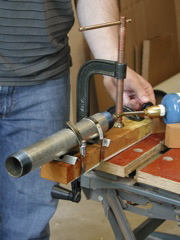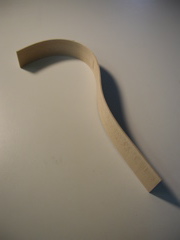Bending the Sides
Steam bending is a very different procedure from other woodworking techniques I have used in the past, so it took some getting used to. The first side I bent took nearly an hour and a half. The second only took a half hour and turned out much better than the first side. The heat is the most important factor for a successful bend. If the iron is too hot, it will scorch the sides, turning them brown or even black (you can use a piece of paper to see if the iron is hot enough to scorch the wood.) If the iron is too cool, the wood will never bend effectively. The sides seemed to bend best when the pipe was at least hot enough to cause drops of water to instantly skip off the pipe on contact. As far as water goes, I kept the sides soaked through for this mandolin. On both sides I had some cracking on the outside edge of the larger bend (it was repairable, but still annoying.) Since I built this mandolin, I have changed my technique a bit. I try to use as little water as possible, wiping or drizzling on water with a rag in order to only wet the exterior on the side that will contact the iron. I also used thinner sides (around 0.1 inches or less compared with 0.125 inches thick on this mandolin.) This resulted in essentially no cracking on my later mandolins.
Planing the Sides

 These are the planed sides
ready for bending. I do not have
access to a thickness sander so I used
a planer to bring the rough cut sides to thickness. The sled in the
second picture helps keep the very thin sides flat while the pass
through the planer. I tried to cut out the sides as close to
quartersawn as possible from the maple block. As far as
width goes, they are about 1.75 inches across. Since the body is
supossed to be about 1.625 inches tall, these sides just made the
needed width considering the compound curves the side must make.
I would go with at least 2 inches on my next attempt at this design so
there is plenty of width for the angle bends of the sides.
These are the planed sides
ready for bending. I do not have
access to a thickness sander so I used
a planer to bring the rough cut sides to thickness. The sled in the
second picture helps keep the very thin sides flat while the pass
through the planer. I tried to cut out the sides as close to
quartersawn as possible from the maple block. As far as
width goes, they are about 1.75 inches across. Since the body is
supossed to be about 1.625 inches tall, these sides just made the
needed width considering the compound curves the side must make.
I would go with at least 2 inches on my next attempt at this design so
there is plenty of width for the angle bends of the sides.
Bending Iron Setup

 My bending setup consists
of a iron pipe supported by two pieces of angle iron and tied down to a
2x3 with pipe clamps. The propane tank is supported by a loose
clamp. This setup worked quite well for my purposes. It is
quick to heat up and holds a fairly steady temperature without too much
fuss.
My bending setup consists
of a iron pipe supported by two pieces of angle iron and tied down to a
2x3 with pipe clamps. The propane tank is supported by a loose
clamp. This setup worked quite well for my purposes. It is
quick to heat up and holds a fairly steady temperature without too much
fuss.
Bending the Sides

 To bend the sides, I first
get the section I
want to work with wet. I then rock the section back
and forth on the iron until it gets very hot through to the opposite
side of the wood. At that point the wood becomes flexible and can bend
surprisingly easily with gentle even presure. After a
few seconds on the heat, the bottom side of the wood dries out, so I
rewet the wood then quickly reapply heat to keep the wood bendable.
To bend the sides, I first
get the section I
want to work with wet. I then rock the section back
and forth on the iron until it gets very hot through to the opposite
side of the wood. At that point the wood becomes flexible and can bend
surprisingly easily with gentle even presure. After a
few seconds on the heat, the bottom side of the wood dries out, so I
rewet the wood then quickly reapply heat to keep the wood bendable.
Finished

 When the side was close
enough to fit on the form, I used rubberbands to secure them and let
them dry and cool. When they are cool they retain there shape
surprisingly well. At this point, I also glued down and sanded
the portions of the side which split. With some sanding, the
sides on the finished project don't show the splits at all.
When the side was close
enough to fit on the form, I used rubberbands to secure them and let
them dry and cool. When they are cool they retain there shape
surprisingly well. At this point, I also glued down and sanded
the portions of the side which split. With some sanding, the
sides on the finished project don't show the splits at all.
